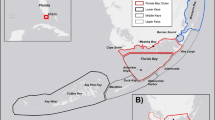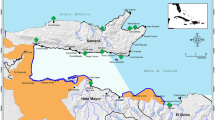Abstract
Local ecological knowledge (LEK) is a valuable way to capture environmental and/or resource changes when there is an absence of biological data, such as in the case of ‘data-limited’ catch- and-release recreational fisheries. A powerful technique in LEK is the use of key informant interviews that selectively focus the most knowledgeable experts, and queries them about experiences, perspectives and beliefs. Here, we used LEK from key informants to obtain an in-depth understanding of angler and guide perspectives on the timing, placement and causes of bonefish decline, and effects on the fishery. Twenty in-depth interviews were conducted with the most-experienced anglers and fishing guides in South Florida (average 42 years of experience). Most respondents described a decline in the fishery that occurred over the 1990s (40% of respondents) and late 2000s (35%), with climate and water quality listed as top causes. Declines in number were larger than the declines in size, with Islamorada being one of the most impacted areas, and Biscayne Bay least impacted. Informants described declines in clientele targeting bonefish, shifts to other fisheries, and to locations outside South Florida. Responses emphasize the contribution of social science research methods, especially incorporating the cumulative knowledge of key stakeholders, to the understanding of ecological systems and their fisheries.



Similar content being viewed by others
References
Adams AJ, Hill JE, Kurth BN, Barbour AB (2012) Effects of a severe cold event on the subtropical, estuarine-dependent common Snook. Centropomus undecimalis Gulf Caribb Res:2413–2421
Ainsworth CH, Pitcher TJ, Rotinsulu C (2008) Evidence of fishery depletions and shifting cognitive baselines in eastern Indonesia. Biol Conserv 141(3):848–859
Anadon JD, Gimenez A, Ballestar R, Perez I (2009) Evaluating local ecological knowledge as a method for collecting extensive data on animal abundance. Conserv Biol 23(3):617–625
Atkinson R, Flint J (2001) Accessing hidden and hard to reach populations: Snowball research strategies. University of Surrey, Guildford, England, UK. Soc Res Update 33, 8 pp
Beaudreau AH, Levin PS (2014) Advancing the use of local ecological knowledge for assessing data-poor species in coastal ecosystems. Ecol Appl 24(2):244–256
Beaudreau AH, Whitney EJ (2016) Historical patterns and drivers of spatial changes in recreational fishing activity in Puget Sound Washington. PLoS One 11(4):e0152190
Berkes F (1993) Traditional ecological knowledge in perspective. Traditional ecological knowledge: Concepts and Cases:1–9
Bernard HR (2011) Research methods in anthropology: qualitative and quantitative approaches, 5th edn. AltaMira Press, Lanham MD
Boucek R, Rehage J (2014) Climate extremes drive changes in functional community structure. Glob Chang Biol 20:1821–1831. https://doi.org/10.1111/gcb.12574
Browder JA, Alleman R, Markley S, Ortner P, Pitts PA (2005) Biscayne Bay conceptual ecological model. Wetlands 25:854–869
Browncombe JW, Cooke SJ, Danylchuk AJ (2017) Spatiotemporal drivers of energy expenditure in a coastal marine fish. Oecologia 183:689–699
Chan MN, Beaudreau AH, Loring PA (2017) Evaluating patterns and drivers of spatial change in the recreational guided fishing sector in Alaska. PLoS One 12(6):e0179584. https://doi.org/10.1371/journal.pone.0179584
Cook GS, Heinen JT (2005) On the uncertain costs and tenuous benefits of marine reserves: a case study of the Tortugas ecological reserve South Florida USA. Nat Areas J 25(4):390–396
Crandall SG, Ohayon JL, de Wit LA, Hammond JE, Melanson KL, Moritsch MM, Davenport R, Ruiz D, Keitt B, Holmes ND, Packard HG, Bury J, Gilbert GS, Parker IM (2018) Best practices: social research methods to inform biological conservation. Australasian J Environl Manag 25:6–23. https://doi.org/10.1080/14486563.2017.1420499
Creswell J (1998) Qualitative inquiry and research design: choosing among five traditions. Sage Publications, Thousand Oaks, CA
Davis A, Wagner JR (2003) Who knows? On the importance of identifying “experts” when researching local ecological knowledge. Hum Ecol 31(3):463–489
Daw TM (2010) Shifting baselines and memory illusions: what should we worry about when inferring trends from resource user interviews? Anim Conserv 13:534–535. https://doi.org/10.1111/j.1469-1795.2010.00418.x
Daw TM, Robinson JAN, Graham NA (2011) Perceptions of trends in Seychelles artisanal trap fisheries: comparing catch monitoring underwater visual census and fishers' knowledge. Environ Conserv 38(01):75–88
Dongol Y, Heinen JT (2012) Pitfalls of CITES implementation in Nepal: a policy gap analysis. Environ Manag 50(2):181–190
Fedler T (2009) The economic impact of recreational fishing in the Everglades region. The Everglades Foundation. http://www.evergladesfoundation.org/wp-content/uploads/2012/04/Report-Bonefish-Tarpon-Trust.pdf. Accessed 1 Jan 2015
Fernandez C, Adams AJ (2004) Fly-fishing for bonefish. Stackpole Books
Frezza PE, Clem SE (2015) Using local fishers’ knowledge to characterize historical trends in the Florida bay bonefish population and history. Environ Biol Fish 98:2187–22023. https://doi.org/10.1007/s10641-015-0442-0
Garcia-Lozano AJ, Heinen JT (2016) Emerging challenges and new directions for the co-management of small scale fisheries in Costa Rica: marine areas for responsible fishing. Mar Policy 73:96–203
Gilchrist GM, Mallory, Merkel F (2005) Can local ecological knowledge contribute to wildlife management? Case studies of migratory birds. Ecol Soc 10(1):20
Grant S, Berkes F (2007) Fisher knowledge as expert system: a case from the longline fishery of Grenada the eastern Caribbean. Fish Res 84(2):162–170
Heinen JT (1995) International conservation agreements. In: Nierenberg WA (ed) Encyclopedia of environmental biology (volume 1). Academic Press, San Diego, pp 375–384
Heinen JT (2010) The importance of a social science research agenda in the management of protected natural areas, with selected examples. Bot Rev 76(2010):140–164
Heinen JT (2012) International trends in protected areas policy and management. InTech chapter 1 in: www.intechopen.com (doi https://doi.org/10.5772/50061). Global issues and trends in the protection of natural areas. 18 pp
Heinen JT, Shrestha-Acharya R (2011) The non-timber forest products sector in Nepal: emerging policy issues in plant conservation and utilization. J Sustain For 30(6):543–562. https://doi.org/10.1080/10549811.2011.567376
Heinen JT, Roque A, Collado-Vides LC (2017) Managerial implications of perceptions attitudes and awareness of residents regarding the Puerto Morelos National Marine Park Mexico. J Coast Res 32(2):295–303
Hind EJ (2015) A review of the past, the present, and the future of fishers’ knowledge research: a challenge to established fisheries science, ICES. J Mar Sci 72:341–358. https://doi.org/10.1093/icesjms/fsu169
Huntington HP (2000) Using traditional ecological knowledge in science: methods and applications. Ecol Appl 10(5):1270–1274
Larkin MF (2011) Assessment of South Florida’s bonefish stock. These Diss 214
Larkin MF, Ault JS, Humston R, Luo J (2010) A mail survey to estimate the fishery dynamics of southern Florida’s bonefish charter fleet. Fish Manag Ecol 17:254–261. https://doi.org/10.1111/j.1365-2400.2009.00718.x
Lavides MN, Polunin NV, Stead SM, Tabaranza DG, Comeros MT, Dongallo JR (2009) Finfish disappearances around Bohol Philippines inferred from traditional ecological knowledge. Environ Conserv 36(3):235–244
Marshall MN (1996) The key informant technique. Fam Pract 13(1):92–97
Matich P, Heithaus MR (2012) Effects of an extreme temperature event on the behavior and age structure of an estuarine top predator, Carcharhinus leucas. Mar Ecol Prog Ser 447:165–178. https://doi.org/10.3354/meps09497
Mazzotti FJ, Cherkiss MS, Parry M, Beauchamp J, Rochford M, Smith B, Hart K, Brandt LA (2016) Large reptiles and cold temperatures: do extreme cold spells set distributional limits for tropical reptiles in Florida? Ecosphere 7:e01439. https://doi.org/10.1002/ecs2.1439
Moller H, Berkes F, Lyver PO, Kislalioglu M (2004) Combining science and traditional ecological knowledge: monitoring populations for co-management. Ecol Soc 9(3): 2 Online: http://www.ecologyand society.org/vol9/iss30art2/
National Oceanic and Atmospheric Administration (2011) Florida keys National Marine Sanctuary Condition Report 2011. U.S. Department of Commerce, National Oceanic and Atmospheric Administration, Office of National Marine Sanctuaries, Silver Spring, MD, 105 pp
Olsson P, Folke C (2001) Local ecological knowledge and institutional dynamics for ecosystem management: a study of Lake Racken watershed Sweden. Ecosyst 4(2):85–104
Papworth SK, Rist J, Coad L, Milner-Gulland EJ (2009) Evidence for shifting baseline syndrome in conservation. Conserv Lett 2:93–100
Phillips LW (1981) Assessing measurement error in key informant reports: a methodological note on organizational analysis in marketing. J Mark Res 18(4):395–415
Rudnick DT, Ortner PB, Browder JA, Davis SM (2005) A con- ceptual ecological model of Florida Bay. Wetlands 25(4):870–883
Santos RO, Rehage JS, Boucek R, Osborne J (2016) Shift in recreational fishing catches as a function of an extreme cold event. Ecosphere 7:e01335. https://doi.org/10.1002/ecs2.1335
Santos RO, Rehage JS, Adams AJ, Black BD, Osborne J, Kroloff EKN (2017) Quantitative assessment of a data-limited recreational bonefish fishery using a time-series of fishing guides reports. PLoS One 12:e0184776. https://doi.org/10.1371/journal.pone.0184776
Serry T, Liamputtong P (2013) Computer-Assisted Qualitative Data Analysis (CAQDAS). Research Methods in Health: Foundations for Evidence-based Practice pp. 380–393. http://researchdirect.westernsydney.edu.au/islandora/object/uws:34971
Shrestha-Acharya R, Heinen JT (2006) Emerging policy issues in non-timber forest products in Nepal. Himalaya 26(1–2):51–54
Thornton TF, Moss ML, Butler VL, Hebert J, Funk F (2010) Local and traditional knowledge and the historical ecology of Pacific Herring in Alaska. J Ecol Anthropol 14(1):81–88
Tremblay MA (1957) The key informant technique: a non-ethnographic application. Am Anthropol 59(4):688–702
Acknowledgements
We are grateful to all the South Florida guides and anglers who graciously shared their experience and passion for fishing with us in interviews, and to Brooke Black who helped us coordinate the interview process. The work by reviewed and deemed exempt by Florida International University’s Institutional Review Board (IRB Protocol exemption #: IRB-14-0235, August 26, 2014). The study was funded by Bonefish and Tarpon Trust and the develop with support from the Florida Coastal Everglades Long-Term Ecological Research program under Gran No. DBI-0620409. This is contribution # 107 of the Center for Coastal Oceans Research in the Institute of Water and Enviroment at Florida International University.
Author information
Authors and Affiliations
Corresponding author
Rights and permissions
About this article
Cite this article
Kroloff, E.K.N., Heinen, J.T., Braddock, K.N. et al. Understanding the decline of catch-and-release fishery with angler knowledge: a key informant approach applied to South Florida bonefish. Environ Biol Fish 102, 319–328 (2019). https://doi.org/10.1007/s10641-018-0812-5
Received:
Accepted:
Published:
Issue Date:
DOI: https://doi.org/10.1007/s10641-018-0812-5




